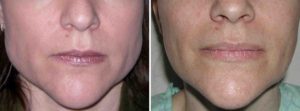Botox, the world’s most popular injectable cosmetic treatment, works by providing a temporary muscle paralyzing effect reducing or eliminating unwanted facial expressions. The vast majority of Botox used for this purpose is done in the forehead and around the eyes. In the masseter muscle, however, repeated Botox injections over time can actually reduce the size of this large muscle improving external appearance and reducing muscle-clenching pain symptoms.
The use of Botox for masseter muscle reduction is well chronicled in the Korean medical journals. In this ethnic group, it is often desired to reduce the size of the muscles for the cosmetic purpose of making the face look less square. Botox done over time is so effective that the surgery historically used to achieve the same effect, masseter muscle reduction and mandibular angle reduction, is now reserved only for patients that demonstrate an actual bony prominence as the primary source of the problem.

While effects can be usually been fairly quick, as judged by less muscle pain and headaches, it takes about 6 months before actual visible shrinking of the muscle is seen. Botox injections should be repeated every 4 months up to a years worth of treatment to see the best results. The decreased size of the muscle is impressive after a year of Botox therapy. I have been surprised to see that the results of masseter muscle reduction seem to be maintained even if no further Botox injections are done. I don’t have a good physiologic explanation as to why that would be so, as Botox does not cause any permanent atrophy in the muscles of facial expression. But I have seen it enough now to realize that it is real clinical finding with Botox use.
Dr. Barry Eppley
Indianapolis, Indiana


